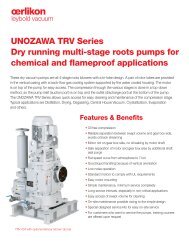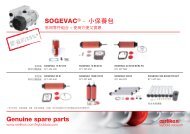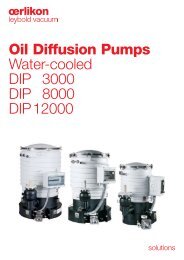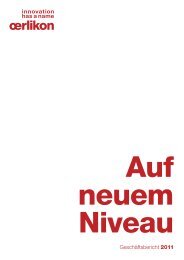Annual Report 2011 (5.07 MB, PDF-File) - Oerlikon
Annual Report 2011 (5.07 MB, PDF-File) - Oerlikon
Annual Report 2011 (5.07 MB, PDF-File) - Oerlikon
You also want an ePaper? Increase the reach of your titles
YUMPU automatically turns print PDFs into web optimized ePapers that Google loves.
30 % higher output with<br />
40 % less labor<br />
“We have really improved our production operation – and the<br />
entire workforce did its part to accomplish this.” Deva Jacob,<br />
Director of the <strong>Oerlikon</strong> Drive Systems Belgaum in Maharashtra,<br />
Southwestern India, is proud of his team. They have partially<br />
or completely automated many work steps in favor of automation.<br />
By engaging all 800 workers in the process, the plant<br />
director was able to demonstrate that automation doesn’t automatically<br />
mean unemployment.<br />
“Today, we produce 30 % more than before, and we do it with<br />
60 % of the people we would have needed before,” Deva says.<br />
“But we didn’t lay off anybody – we actually created more<br />
jobs.” The reason: rapidly rising demand for the gear components<br />
and complete gears produced at the plant. A total of<br />
250 000 gear components and nearly 4 000 complete gears<br />
now leave the factory each month. The facility serves an international<br />
customer base, namely the United States. Domestic<br />
sales, however, are expanding due to Indian construction and<br />
agricultural equipment industry demand.<br />
High acceptance among employees<br />
In defining and carrying out this modernization effort, Deva integrated<br />
the entire workforce into the process. All employees<br />
did their part: machine operators, maintenance technicians,<br />
production designers, tool suppliers and master technicians.<br />
Deva and his team optimized 100 machines to eliminate a<br />
number of manual procedures. The milling and deburring of<br />
loose gears, the drilling of oil conduits and the cutting, lathing<br />
and grinding processes have been partially or fully automated.<br />
Deva introduced lean production methods and set up production<br />
lines in places where products had been made in cells.<br />
Components are no longer transported manually; instead, they<br />
move between the various workstations on conveyor belts. A<br />
total of 30 production lines are now working at the same time.<br />
The transition from batch mode production to flow production<br />
accounts for the improvements in both efficiency and adherence<br />
to schedules.<br />
Integration of the workforce was crucial to the projects’ success.











